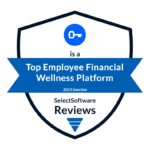With just 13% of frontline workers considered financially healthy, financial illness is one of the biggest unaddressed opportunities for any employer with a large frontline workforce. It costs employers an additional $1,200 per employee in higher healthcare costs each year, hinders productivity, and compromises workplace safety. Financial challenges even prevent employees from getting to work as scheduled, leading to absenteeism and turnover.
The first step to helping frontline employees requires understanding how and why their financial needs differ from the rest of the workforce, and acknowledging that supporting them requires a different approach than financial wellness, point solutions, or retirement benefits offer.
Keep reading to learn more about what inspired benefits leaders at Amazon, Unum, and a Fortune 10 employer to reconsider their frontline financial health benefits.
1. Amazon: Letting employees define what they need
Amazon recognized that assuming what employees need often leads to solutions that miss the mark. Instead, the company surveyed its frontline employees to learn about different benefits they valued, financial and otherwise. The respondents consistently ranked financial assistance as a top priority when presented with various options.
To better understand employees’ financial needs, HR leaders then dug deeper and asked specific, empathetic questions such as: “Have you ever had to decide between buying groceries and paying your electric bill?” These insights helped Amazon realize that supporting frontline employees with financial wellness benefits and retirement solutions was not meeting them where they truly were. Many were grappling with basic financial challenges and issues including housing and lack of transportation.
Brightside Financial Care helps Amazon employees tackle all financial needs, including those that are urgent, while also addressing the root causes of their financial challenges. While the goal is always to triage emergency situations quickly and effectively, no matter where in the country the employee is located, it’s also to find real solutions that empower them to establish financial stability so they can move forward in their financial health journey.
Amazon has seen such a positive impact from offering Brightside Financial Care that it chose to expand the benefit to provide even more employees with unlimited support for all financial needs, including housing hardship, money emergencies, debt and credit management, emergency savings, and life events such as divorce, retirement, and more.
2. Unum: Going beyond traditional financial wellness
Unum has long offered employees a 401(k) plan, webinars, and self-serve financial resources. Yet, employees continued to cite financial stress as a top issue. After assessing their frontline employees’ needs, Unum’s benefits leaders determined that traditional financial wellness wasn’t enough to move the needle or support these employees’ financial challenges.
Unum sought to find a financial health partner that:
- Used a human-centered approach that would connect employees with an empathetic person who could support them in finding solutions for their financial challenges
- Had a sole focus on employee financial health, with no hidden agendas or conflicts of interest.
- Offered integration capabilities with Unum’s HR system to include helping employees navigate to other relevant benefits
Brightside checked all the boxes, offering ongoing personalized financial support combined with vetted and safe solutions employees cannot find elsewhere.
3. Fortune 10 employer: Tackling social determinants of health
For this Fortune 10 employer, addressing social determinants of health (SDOH) was central to its benefits strategy, particularly for distribution center workers. The team sought to reduce 401(k) hardship withdrawals, help employees achieve financial stability, and provide direct support for employees facing severe financial crises.
Once it introduced Brightside Financial Care as a benefit, it saw those results and more. For example, Brightside helped one worker who was living in his car secure a free resource to pay for an apartment deposit and cover the first several months of his rent within seven days, transforming his situation. This kind of support has been life-changing for employees and has driven measurable outcomes for the employer.
Join the employers who are thinking differently about financial health
These are just a few of the Fortune 500 employers who are addressing financial illness head-on with Brightside. In turn, they’re transforming frontline employees’ lives and seeing significant business value in results including decreased employee financial stress after they engage with Brightside, reduced workplace safety incidents, an increase in hours worked per employee, and reduced attrition.
If you’re a benefits leader curious about what could happen by taking a different approach to supporting financial health, click here to learn more about Brightside Financial Care.





